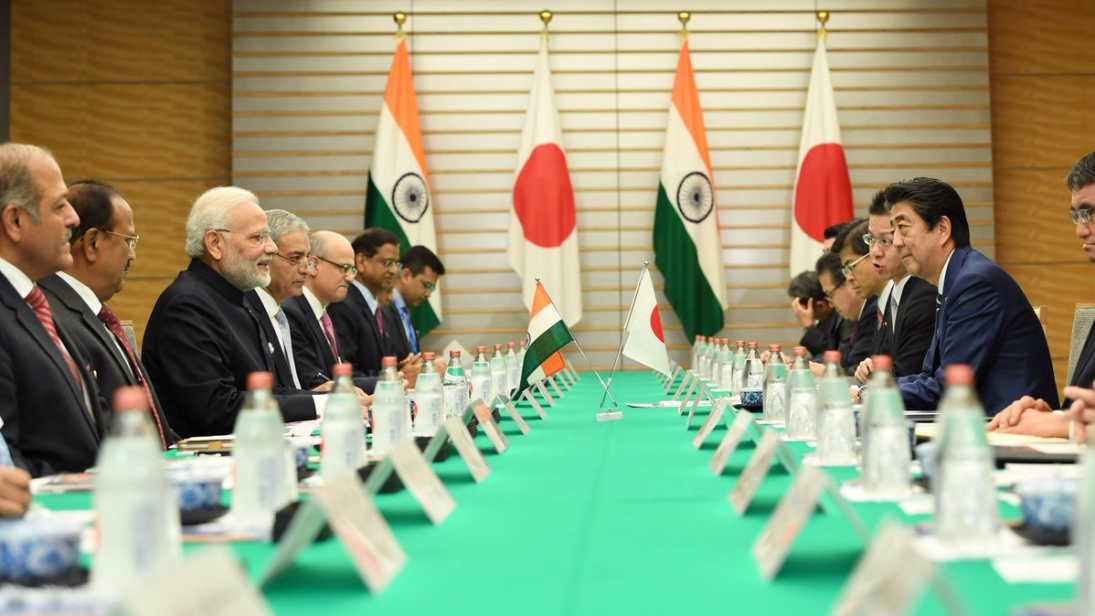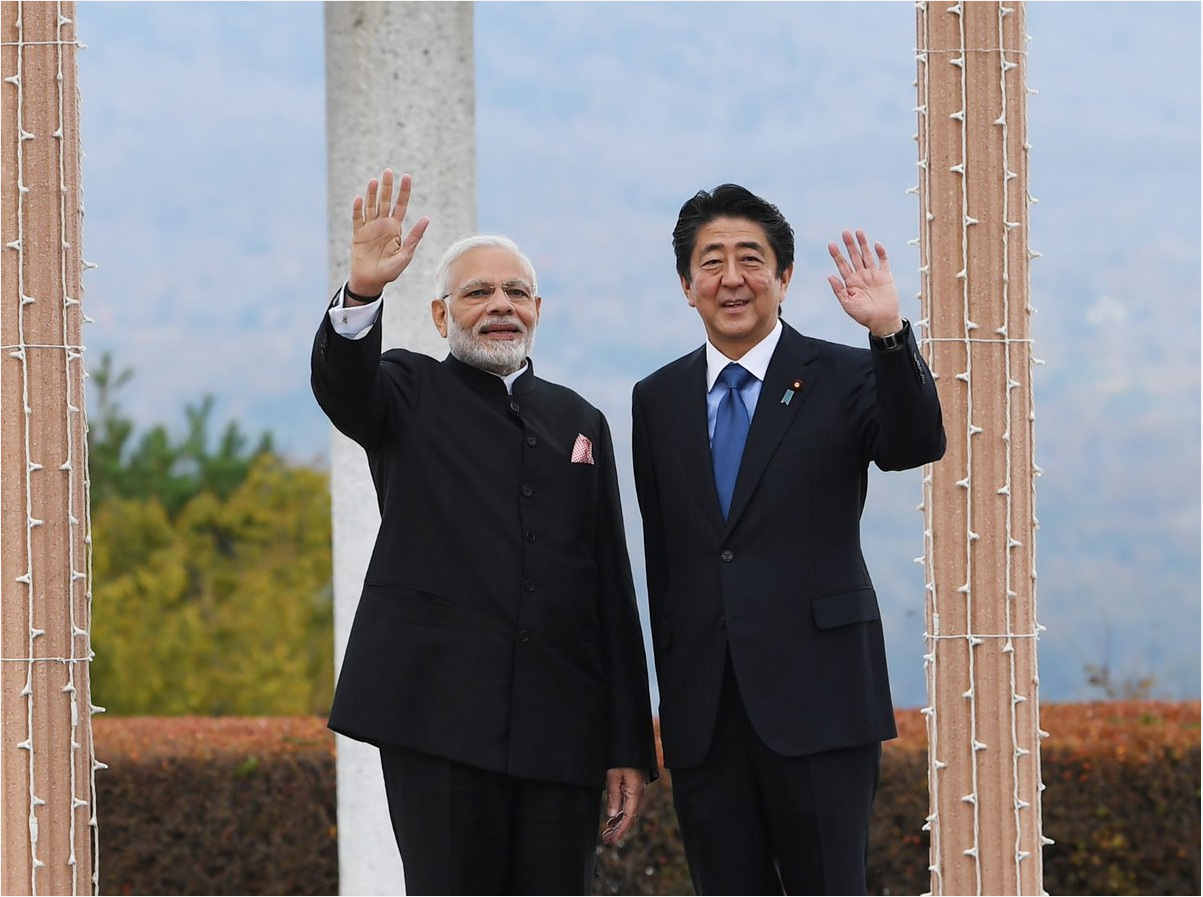
In what was his third visit to the country, Prime Minister Narendra Modi traveled to Japan to attend the 13th annual India-Japan summit with Prime Minister Shinzo Abe. The summit occurred amidst concerns raised by some commentators about the sustainability of the India-Japan strategic partnership when both countries are focusing on ameliorating relations with China. However, the joint vision statement issued after the visit laid those fears to rest, suggesting that both leaders are keen to further strengthen their relationship, not only to benefit each other but also to ensure regional security.
Converging Visions of the Indo-Pacific
India’s commitment to the Quad and a free and open Indo-Pacific has been questioned in recent times, especially after Modi’s visit to Wuhan in April, which was to “reset” India’s ties with China. Then in June, at the Shangri-La Dialogue, Modi asserted that India didn’t see the Indo-Pacific region as “a club of limited members” or “a grouping seeking to dominate,” which seemed like an underplaying of the Quad and an oblique reference to not wanting to exclude China from India’s strategy in the region. This seemed to deviate from the Japanese Indo-Pacific vision that sought to establish a counter-mechanism of likeminded countries against Chinese dominance in the region.
However, it now seems like Japan has softened its stance and found value in including China where possible. Abe just returned from a trip to China, the first in seven years for a Japanese Prime Minister, right before he received Modi. Japan and China have had a testy relationship under Abe, punctuated by tensions over a territorial dispute over the Senkaku/Diayou islands in the East China Sea. Interestingly, the premise for India-Japan strategic cooperation at its inception in the early 2000s was the security of Japanese ships in the Indian Ocean, exacerbated by Tokyo’s anti-China sentiment. However, U.S. President Donald Trump’s recent trade war has pushed Tokyo and Beijing to find common ground and improve their bilateral relationship. In fact, Japan has even sought to participate in China’s multinational, mega-infrastructure project, the Belt and Road Initiative (BRI), even if it may ultimately be to expand Japan’s own presence abroad through this Chinese initiative. This shifting stance may explain Japan now embracing India’s view of a free and open Indo-Pacific, which in the summit statement they characterized as “inclusive and open to all,” language that is reminiscent of Modi’s Shangri La speech.
Importantly, the joint statement also reinforces the role of the Association of Southeast Asian Nations (ASEAN) in both India and Japan’s Indo-Pacific strategies. ASEAN nations feared being kept out of the Quad concept mooted by Abe, of which the United States, Australia, and India are other members. But Abe and Modi allayed these apprehensions with the two leaders stating in the joint statement of the recent summit that “ASEAN unity and centrality are at the heart of the Indo-Pacific concept.”
What was also significant was the two leaders reiterating their commitment to cooperating in neighboring regions, with collaborative projects in Sri Lanka, Myanmar, and Bangladesh as well as in Africa, a move to counter the influence of China in these countries under the BRI. Indeed, on the one hand, both India and Japan want to have a cordial relationship with Beijing, and on the other hand, they are involved in a hedging strategy vis-à-vis China to make sure that Beijing does not get a dominant position in the Indo-Pacific.

Enhancing Defense Cooperation
India and Japan announced their intention to hold a 2+2 dialogue involving their foreign and defense ministers, modeled on the India-United States 2+2 dialogue. Strategic and defense cooperation is a crucial component of India-Japan relations and engagement between their diplomats and armed forces is regular and active, but bureaucratic wrangling sometimes creates impediments in the relationship. Th 2+2 dialogue promises to synergize the policies of both countries. A 2+2 dialogue also demonstrates how important the dyadic relationship has become for both countries, since foreign and defense ministers are at senior levels of the government.
To enhance the depth of their bilateral security and defense cooperation, both countries have decided to begin negotiations on the Acquisition and Cross-Servicing Agreement (ACSA). ACSA will allow Indian warships operating in the western Pacific to refuel and replenish supplies at Japanese military bases. Similarly, Japanese ships in the Indian Ocean could replenish at Indian bases. India has a similar agreement only with the United States. Japan recently set up a military base in Djibouti, which can be utilized by India to augment the power of the Indian Navy in the Indian Ocean. This will ensure both navies broaden their scope of interaction by and more synergy between the two will foster an understanding of each other’s operational strategies.
Modi’s visit also filled a crucial lacuna in the India-Japan partnership: cooperation on defense equipment and technology. During the visit, both leaders agreed to strengthen defense technology cooperation, which has immense scope for growth in the economic and security sectors. The two countries have agreed to begin with research in the area of Unmanned Ground Vehicle (UGV) and Robotics, which can be extended to other non-combatant products and finally to combatant items. Under Abe, Japan is searching for a market for its defense products, which is now legally possible since Japan relaxed its restriction on defense exports in 2014. Japan is a repository of advanced technology both in the civilian and defense sector, while India is the second largest buyer of arms from abroad. Undoubtedly, technology cooperation will not only provide economic benefits, but will deepen the defense cooperation between the two and can attract more regional allies if they sell such products to other countries.
Future of the Partnership
The recent India-Japan summit has indeed helped to deepen defense ties between the two countries. Both India and Japan are looking for economic benefits to emerge from this strategic partnership because such benefits are important to sustain a strategic relationship and hence, the two sides are focusing more on manufacturing and defense technology cooperation. The proposed 2+2 dialogue will institutionalize the India-Japan relationship, facilitating their adoption of common strategies in the Indo-Pacific that bring shared prosperity and ensure regional stability.
***
Image 1: MEA India via Twitter
Image 2: MEA India via Twitter


